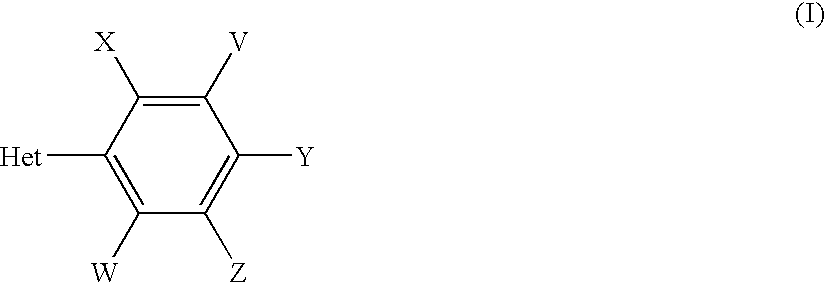Trifluoromethyl-substituted spirocyclic ketoenols
a trifluoromethyl and spirocyclic technology, applied in the field of trifluoromethylsubstituted spirocyclic ketoenols, can solve the problems of insufficient compatibility of these compounds with plants, in particular with respect to crop plants, and the activity spectrum of herbicidal, acaricidal and insecticidal activities and/or the activity spectrum
- Summary
- Abstract
- Description
- Claims
- Application Information
AI Technical Summary
Problems solved by technology
Method used
Image
Examples
preparation examples
Example (I-1-a-1)
At 60° C., 9 g of the compound of Example (I-1) in 20 ml of anhydrous dimethylformamide (DMF) are added dropwise to 7.4 g of potassium tert-butoxide in 30 ml of DMF, and the mixture is stirred at 60° C. for 2 h. The reaction solution is then poured into 250 ml of ice-water and, at 0-10° C., acidified with concentrated hydrochloric acid to pH 2, and the solid is filtered off with suction and dried.
The crude product is boiled in methyl tert-butyl ether (MTBE) / n-hexane, filtered off with suction and dried.
Yield: 6.15 g (74% of theory); m.p.: >250° C.
The following compounds of the formula (I-1-a) were prepared similarly to Example (I-1-a-1) and in accordance with the general preparation instructions:
(I-1-a)Ex. No.VWXYZm.p. ° C.IsomerI-1-a-2HHCH3HCH3245βI-1-a-3HHCH3CH3CH3175βI-1-a-4HClClCH3H>250βI-1-a-5CH3CH3CH3CH3H>250βI-1-a-6HCH3CH3ClH>248βI-1-a-7HHBrHCH3212β
Example (I-1-b-1)
1.42 g of the compound of Example (I-1-a-1) are initially charged in 40 ml of anhydrous ethyl a...
example ii-1
7.86 g of ethyl 1-amino4-trifluoromethyl-cyclohexane-1-carboxylate hydrochloride are initially charged in 30 ml of anhydrous acetonitrile, 13.8 g (0.1 mol) of ground potassium carbonate are added and, at 5-10° C., 5.9 g of mesityleneacetyl chloride in 10 ml of anhydrous acetonitrile are added dropwise over a period of 10 min. The mixture is stirred at room temperature for 3 h.
The reaction solution is poured into 200 ml of ice-water and the pH is checked. After addition of seed crystals, the precipitate is filtered off with suction and taken up in methylene chloride, dried and concentrated. The residue is purified chromatographically on silica gel using methylene chloridelethyl acetate 10:1.
Yield: 9.7 g (83.6% of theory); m.p.: =148° C.
The following compounds of the formula (II) were prepared analogously to Example II-1 and in accordance with the general preparation instructions:
(II)Ex. No.VWXYZR8m.p. ° C.IsomerII-2HHCH3HCH3CH3138βII-3HHCH3CH3CH3CH3158βII-4HCH3ClClHCH3145βII-5CH3CH3C...
example xiv-1
113.33 g (1.18 mol) of ammonium carbonate are initially charged in 337 ml of water, 25.04 g (0.51 mol) of sodium cyanide are added and 42.1 g (0.25 mol) of trifluoromethyl-cyclohexan4-one in 379 ml of ethanol are added dropwise. The reaction solution is stirred at 55-60° C. for 10 h. The pH of the mixture is then adjusted to pH 1-2 using concentrated hydrochloric acid and the precipitate is filtered off with suction and washed with water (49.3 g {circumflex over (=)}83% of theory, m.p.: >250° C.). 48.7 g of the resulting hydantoin A are suspended in 270 ml of 30% strength KOH solution and stirred at reflux under protective gas for 1 day. The reaction mixture is, at 0-10° C., acidified with hydrochloric acid to pH 5.2-5.3 and the precipitate is filtered off with suction. The crude product B is then initially charged in 260 ml of anhydrous methanol, and, at 0-5° C., 21.3 ml (0.253 mol) of thionyl chloride are added dropwise. The suspension is stirred at 0° C. for 30 min and then at 40...
PUM
| Property | Measurement | Unit |
|---|---|---|
| Fraction | aaaaa | aaaaa |
| Fraction | aaaaa | aaaaa |
| Fraction | aaaaa | aaaaa |
Abstract
Description
Claims
Application Information
 Login to View More
Login to View More - R&D
- Intellectual Property
- Life Sciences
- Materials
- Tech Scout
- Unparalleled Data Quality
- Higher Quality Content
- 60% Fewer Hallucinations
Browse by: Latest US Patents, China's latest patents, Technical Efficacy Thesaurus, Application Domain, Technology Topic, Popular Technical Reports.
© 2025 PatSnap. All rights reserved.Legal|Privacy policy|Modern Slavery Act Transparency Statement|Sitemap|About US| Contact US: help@patsnap.com



